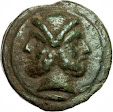The weight and beam may have been from different scales, but both look (and were sold as) ancient. I have an old US steel-yard scale. Pictures of both and some of my weights are shown below.
The vendor's description; Timeline Auctions, London:
ROMAN STEELYARD AND WEIGHT GROUP; 1st-2nd century AD
A mixed group comprising: a bronze steelyard with incised
gradations, pierced bulb, knop finial, two loops with chains; a tongue-shaped
lead weight with stamped profile bust to one face, graffito inscription
'ERLILAFAV' to one face, '[...]CID[...]' to the other, loop above. 380 grams
total, 73-22cm (3 - 8 5/8"). [2]
Fine condition.
Provenance - From a private collection; formed 1965-1975.
Shown above are two scales:
·
US steel-yard scale – 22” overall length; weight = 985 grams;
beam weight = 800 grams
o
Low range scale = 6 to 28 lbs
§ Center to scale weight = 40 mm
§ Center to end of beam on weighing side = 470 mm
§ Scale marked in 2 lb increments 37.7 mm apart
§ 6 lb mark is 54 mm from center
o
High range scale = 30 to 100 lbs
§ Center to scale weight = 10 mm
§ Center to end of beam on weighing side = 480 mm
§ Scale marked in 10 lb increments 53.5 mm apart
§ 10 lb mark is 72 mm from center
·
Roman steel-yard scale – 8” overall length; weight = 307
grams; beam weight = 70 grams
o
Low range scale = ? to ?
§ Center to scale weight = 58.2 mm
§ Center to end of beam on weighing side = 142 mm
§ Scale marked in ? increments ___ mm apart
o
High range scale = ? to ?
§ Center to scale weight = 44.7 mm
§ Center to end of beam on weighing side = 142 mm
§ Scale marked in ? increments ___ mm apart
o
There are 3 sets of marks on the weighing end of the beam. My
measurements averaged 18.4 mm apart, but they varied from 17.4 to 20 mm apart.








